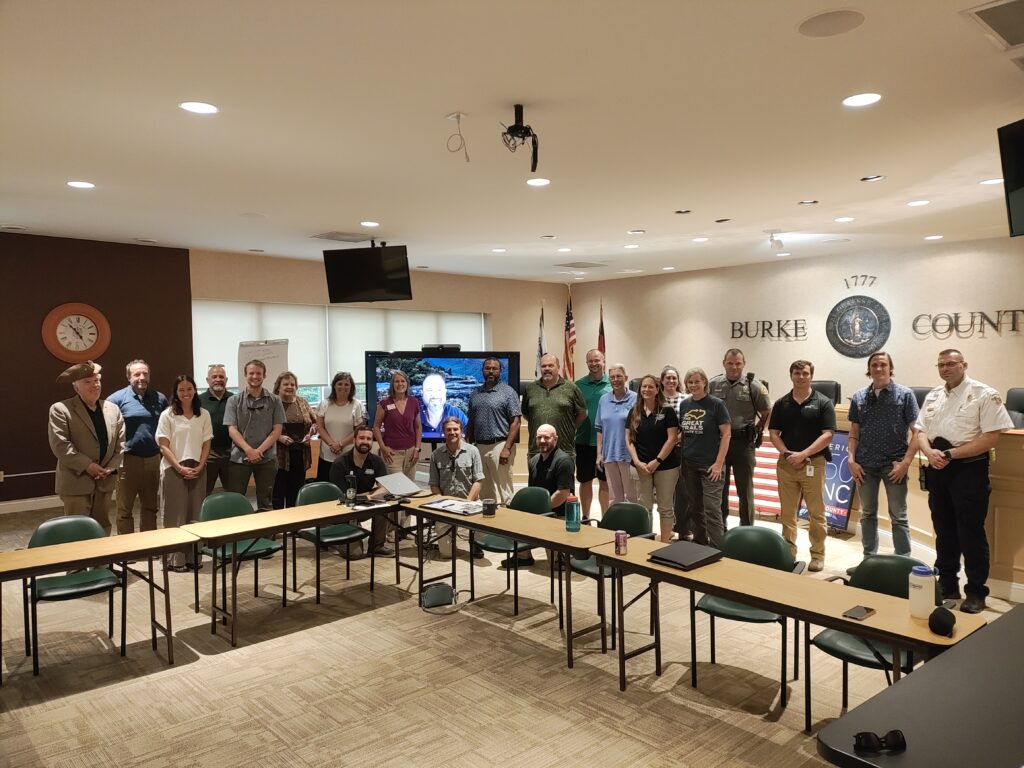
Burke County Trails Summit: Stronger Together
With a national historic trail, four state trails, two state parks, two regional parks with trail systems, numerous municipal paths and greenways, plus our rivers, Burke County offers an impressive 290 plus miles of trail experiences. These miles collectively serve hikers, bikers, equestrians, and paddlers — though not every mile is open to every type of user. Because of this extensive and diverse network, it is essential for everyone involved in trail planning and development to come together regularly.
Now in its fourth year, the Burke County Trails Summit has become the go-to gathering for the people behind the trails — the planners, builders, partners, and advocates who turn ideas into miles on the ground. Built on a simple but powerful premise — we go farther when we go together — the Summit brings together representatives from nonprofits, local governments, state agencies, and partner organizations, all sharing a commitment to expanding, connecting, and improving the trail experience in Burke County.
Sharing Project Updates and Priorities
A formal agenda isn’t needed at this meeting; instead, each attendee having the chance to share updates on their organization’s work is a major focus. As such, the meeting opened with each attendee taking five minutes to introduce themselves and provide project updates. Knowing what stage each trail is in across the county helps guide decisions and support future connections. During this time, participants also created a list of key topics that needed deeper discussion. The following topics were discussed during the final hour of the meeting.
The Economic Power of Trails
While trails are free to use in Burke County, their economic impact is far from invisible. At the Summit, partners emphasized the importance of continually highlighting trails as a driver of local economic growth. As an example, a detailed economic impact study for Valdese Lakeside Park showed the park generates over $882,000 annually in spending in Valdese from visitors, along with $22,000 in property tax revenue and $330,000 in resident savings from health and transportation benefits — resulting in a total annual economic impact of more than $1.24 million.
In addition to attracting visitors who support local businesses, those businesses create jobs. Statewide data further reinforces this connection: North Carolina’s outdoor recreation economy contributed $16.2 billion in 2022 and supports over 145,000 jobs. Trails were also named the #1 activity people want to try or do more of in the 2025 Statewide Comprehensive Outdoor Recreation Plan. As Burke continues to invest in connectivity and access, trails are poised to be a powerful tool not just for quality of life, but for long-term economic resilience.
Valdese Parks and Recreation Director David Andersen shared, “Town of Valdese participated in the Creating Outdoor Recreation Economies Program through NC Commerce and has a strategic plan to follow in this area.” Similarly, Mountain Bizworks offered a seven-month “Building Outdoor Communities” that Beth Heile, Ed Phillps and Katherine Christie attended as Burke County representatives and refer to the recommendations of the completed plan in looking for gaps in amenities and businesses.
Investing for the Future
At every level of government, leaders are asked to make tough choices about where to invest limited resources. Trails may seem optional compared to more traditional infrastructure, but they offer a rare return — serving residents and attracting visitors, all while boosting public health, safety, and economic vitality. We know trails make an impact: local counts show that 30–50% of tax-paying residents are using their community trails.
At the same time, Discover Burke County Tourism CEO Ed Phillips commented, “Trails are attracting visitors whose spending supports local businesses which helps grow a tax base that reduces the burden on property owners.” When tourism is strong, local businesses thrive, new businesses open, and increased sales tax revenue can help local governments keep property taxes lower for residents. Trails have even been cited as a factor in company relocations — because quality of life matters to workforce recruitment. Importantly, trails are also one of the most cost-effective investments a community can make: natural surface trails can be built for as little as $30,000 per mile — and even less when volunteers are involved — making them dramatically more affordable than many other types of infrastructure. As Burke County continues to plan for the future, investing in trails is not a luxury — it’s a long-term strategy for stronger communities and smarter growth.
New State Support and Local Partnerships
The State of North Carolina has recognized that trails are more than a recreational amenity — they are critical infrastructure for tourism, health, transportation, and economic development. That’s why recent legislation and state programs have prioritized funding for trails, especially those that connect communities. Through the advocacy work of the Great Trails State Coalition, North Carolina has made historic investments in trails in recent years: $29.15 million for the Complete the Trails Fund in 2021, $2 million for DOT feasibility studies in 2022, $25 million for the new Great Trails State Program in 2023, plus an additional $5 million for completing state trails. In 2024, the state further cemented its commitment by officially designating the third Saturday in October as Great Trails State Day, an annual celebration recognizing the value of trails statewide.
What makes these investments even more effective is the role of local nonprofits. Organizations like the Burke River Trail Association and Foothills Conservancy are not only writing grants and coordinating volunteers but also providing matching funds and project management — allowing public dollars to go further. With these new funding opportunities and strong legislative momentum, Burke County and its municipalities are well-positioned to build on this support and bring meaningful, community-driven trail projects to life. A perfect example was shared by Sarah Chabaane, Burke County Trails Coordinator: the partnership between Burke County, Friends of Fonta Flora State Trail, and OVNCST-Friends (Overmountain Victory National Historic Trail NC Friends), to split the cost of the Canal Bridge sidewalk project.
Improving Safety with New Trail Markers
After years of recognizing the need for a faster, more accurate way to locate people in distress on trails and waterways, Burke County Emergency Services turned that vision into reality with a $50,000 grant from Duke Energy. Last year, the waterway marker system was deployed; this year, hiking trail markers are being rolled out.
At the Summit, John Hood, Deputy Director of Burke County Emergency Services, shared the blue diamond trail markers that will be installed on trails and asked land managers to provide a two-letter code for their area (for example, “VL” for Valdese Lakeside Park), along with the number of markers needed. BCES will handle installation and use GPS to record each marker’s exact location for rescue purposes. Each marker will include a unique identifier — much like a highway mile marker — and locations will be mapped and distributed to regional 911 centers. This initiative is a powerful example of how public safety and outdoor recreation can work together to improve both visitor experience and emergency response.
Attendees also discussed the responsibility of the land managers to promote trail safety and possibly a trail difficulty rating system.
New Policy Opportunity: Trails in NCDOT Right-of-Way
One of the most exciting developments in statewide trail policy is a long-awaited shift in how trails can be built within NCDOT right-of-way. Until now, trail construction in these corridors has been limited to costly, engineered sidewalks and side paths — often delaying projects or putting them out of reach for local communities.
Three summit attendees, Shane Prisby, Smith Raynor and Palmer McIntyre, were part of the policy working group and shared the details. Thanks to consistent advocacy from the Great Trails State Coalition and local trail partners across North Carolina, NCDOT has released a first draft of new guidelines that would allow natural surface trails within state highway ROW. This change represents a major step forward — enabling faster, more affordable trail connections while still meeting safety and access standards. The draft policy is the result of close collaboration among NCDOT, NC State Parks, FHWA, and trail advocates, and reflects a growing recognition that trails are essential transportation infrastructure.
Honoring History Through Trails
At the Summit, representatives from the Overmountain Victory Trail – Brian Oliver, Bryant Lindsey and Linda Lindsey –provided an update on their work to prepare for the upcoming America 250 commemoration. As a National Historic Trail, the Overmountain Victory Trail traces the route of patriot militia forces during the Revolutionary War and plays a powerful role in connecting our landscapes to our shared history. In anticipation of the 250th anniversary in 2026, the trail partners are working closely with local, state, and federal agencies to highlight these historic connections, engage communities, and encourage more people to explore the stories hidden along North Carolina’s trails. Led by Ed Phillips, Burke County has an America 250 NC Committee to help prepare for the United States’ 250th anniversary in 2026. The committee is responsible for the blue America 250 banners placed in downtowns and at public schools.
Moving Forward in Outdoor Recreation
At the end of the meeting, attendees left with new strategies and to-do lists that will continue to move Burke County forward in outdoor recreation. “I used to get stressed when planning this event — especially the first one — thinking we needed a jam-packed, highly structured agenda,” said Beth Heile, Executive Director of the Burke River Trail Association and organizer of the Summit. “But after that initial gathering, we all realized that simply getting together was reason enough. The connections and momentum built here are exactly what move trails forward.”
—————————————–
Attendee List (grouped by organization): Linda Lindsey (OVNCST-Friends), Bryant Lindsey (OVNCST-Friends), Brian Oliver (OVNCST-Friends), Jeffrey Allison (National Park Service), Smith Raynor (NC State Trails), Lance Huss (South Mountains State Park), Nora Coffey (Lake James State Park), Shane Prisby (Foothills Conservancy of NC), Bryan Fish (City of Morganton), Stephen Fox (City of Morganton), David Andersen (Town of Valdese), Sarah Chabaane (Burke County), Bradley Kirkley (Burke County), Alan Glines (Burke County), Bradley Kirkley (Burke County), Beth Heile (Burke River Trail Association), Brett Hartis (Duke Energy), Ed Phillips (Discover Burke County), Melissa Patton (Carolina Land and Lakes), Palmer McIntyre (Great Trails State Coalition), Grant Buckner (Catawba Riverkeeper), Ellie Riggs (Catawba Riverkeeper), Tyler Hickman (NC DEQ), John Hood (Burke County Emergency Services), James Robinson (Burke County Emergency Services), and Dominic Minor (Burke County Emergency Services)
—————————
Pictured (standing l-r):, Bryant Lindsey (OVNCST-Friends), Bradley Kirkley (Burke County), Ellie Riggs (Catawba Riverkeeper), Brian Oliver (OVNCST-Friends), Grant Buckner (Catawba Riverkeeper), Linda Lindsey (OVNCST-Friends), Melissa Patton (Carolina Land and Lakes), Beth Heile (Burke River Trail Association), on screen Brett Hartis (Duke Energy), Bryan Fish (City of Morganton), Stephen Fox (City of Morganton), David Andersen (Town of Valdese), Smith Raynor (NC State Trails), Nora Coffey (Lake James State Park), Sarah Chabaane (Burke County), Palmer McIntyre (Great Trails State Coalition), Lance Huss (South Mountains State Park), Lance Huss (South Mountains State Park), Dominic Minor (Burke County Emergency Services), Tyler Hickman (NC DEQ), James Robinson (Burke County Emergency Services), (kneeling l-r): Shane Prisby (Foothills Conservancy of NC), Jeffrey Allison (National Park Service), John Hood (Burke County Emergency Services). Not pictured: Alan Glines (Burke County), Ed Phillips (Discover Burke County)
